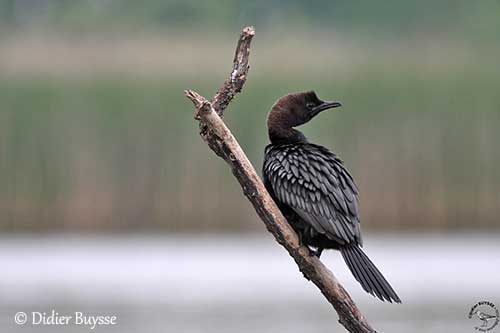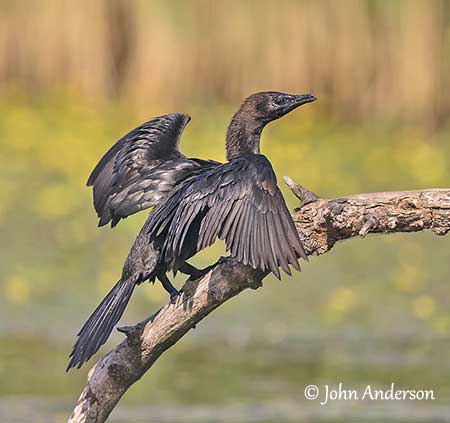
Fr: Cormoran pygmée
Ang: Pygmy Cormorant
All: Zwergscharbe
Esp: Cormorán Pigmeo
Ita: Marangone minore
Nd: Dwergaalscholver
Sd: dvärgskarv
Photographers:
John Anderson
John Anderson Photo Galleries
Didier Buysse
Vision d’Oiseaux
Text by Nicole Bouglouan
Sources:
HANDBOOK OF THE BIRDS OF THE WORLD vol 1 by Josep del Hoyo-Andrew Elliot-Jordi Sargatal - Lynx Edicions - ISBN: 8487334105
BIRDS OF THE MIDDLE EAST by R.F. Porter, S. Christensen, P Schiermacker-Ansen C.Helm - ISBN: 0713670169
Vogelwarte.ch – Birds of Switzerland
Pygmy Cormorant - Hellenic Ornithological Society
Pygmy Cormorant (Phalacrocorax pygmaeus)
AUA Acopian Center for the Environment
Wikipedia, the free encyclopaedia
Pygmy Cormorant
Microcarbo pygmaeus
Suliformes Order – Phalacrocoracidae Family
INTRODUCTION:
The Pygmy Cormorant is the smallest species of the family Phalacrocoracidae. It occurs is a large European area where it is patchily distributed. The northernmost populations move southwards after breeding.
This species is mainly found in vegetated pools, lakes and river deltas, but it avoids mountainous, cold and dry regions. It feeds on various small fish species caught by pursuit-diving. The nest is built among the dense vegetation, in trees or shrubs, and occasionally in reeds on small floating islands.
The Pygmy Cormorant is threatened by degradation of wetland habitats, persecution and hunting, but despite these problems, the population trend is increasing or stable.

DESCRIPTION OF THE BIRD:
Biometrics:
Length: 45-55 cm
Wingspan: 80-90 cm
Weight: 565-870 g
The Pygmy Cormorant is a small cormorant with long tail and short-thick bill.
The adult in breeding plumage has black plumage overall, but we can see scattered, short, white filoplumes on head, neck and body.
Mantle, scapulars and wing-coverts are mostly blackish-grey with greenish/purplish gloss, and show a scaly pattern formed by narrow, dark feather fringes. Flight-feathers and rectrices are blackish.
On the head, the eye area shows dotted white feathers. A short erectile crest is sometimes visible on the forecrown.
However, as the breeding season progresses, the white filoplumes disappear soon, involving an increasing chestnut tinge on rear head and large part of neck.
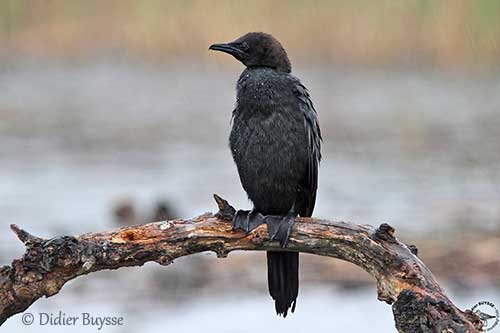
The non-breeding adult has mostly dark brown/rufescent-brown head and neck, whereas the forecrown is darker. Wing-coverts and scapulars are more contrasting, due to the silvery feathers with pale edges.
The area from the gape to chin and throat is brownish-white, but the underparts are duller, with some buffy spots on belly.
Bill and gular pouch are black at the beginning of the breeding season. The bill itself is flesh-coloured on gape and base of mandible, but the culmen is dark brownish-grey. The eyes are dark brown. Legs and webbed feet are blackish, but the webs are tinged brown.
Male and female are similar.
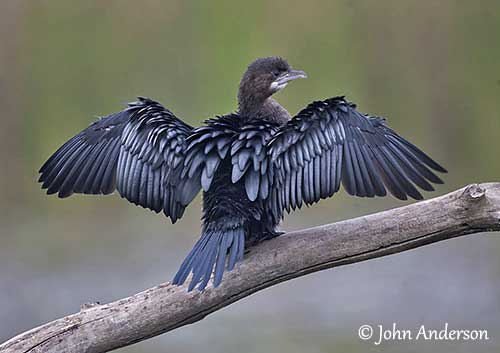
The juvenile resembles non-breeding adult with browner plumage overall. On the foreneck, the centre is usually paler. The upper breast is brownish and contrasts with the paler, dark-streaked belly. The thighs are blackish.
On the upperparts, the new feathers in autumn are greyer with little sheen. Mantle, scapulars and wing-coverts show dark subterminal fringes and thin, pale fringes and tips involving scaly pattern.
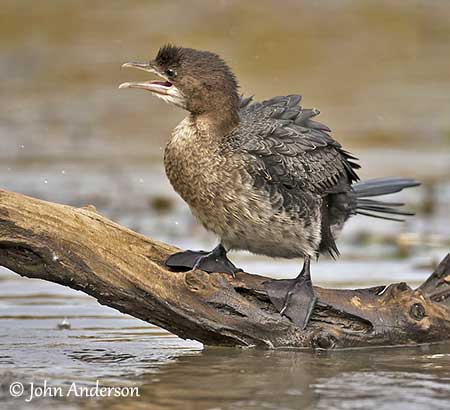
RANGE:
The Pygmy Cormorant breeds from SE Europe and Turkey, E to Aral Sea region and Tajikistan, S to Israel and Iraq.
The northern populations migrate after breeding to spend the winter in the southern part of the range.
HABITAT:
The Pygmy Cormorant lives in wetlands including pools with vegetation, lakes and river deltas, but if favours ricefields or flooded areas with trees and shrubs providing nesting sites. It usually avoids mountainous, cold and dry areas.
During winter, it occurs in waters with higher salinity, in estuaries and reservoirs.
CALLS AND SONGS: SOUNDS BY XENO-CANTO
The Pygmy Cormorant typically produces croaking sounds and grunts at colonies. It is usually silent elsewhere.
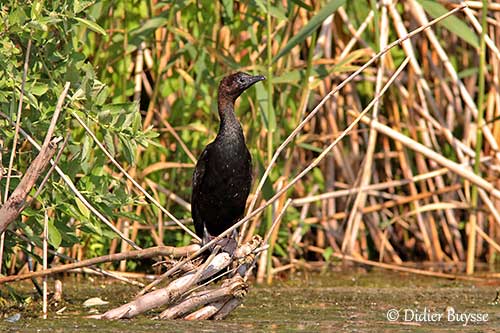
BEHAVIOUR IN THE WILD:
The Pygmy Cormorant feeds on small fish up to 15 cm long and about 15 grams. Occasionally, it also takes aquatic animals and molluscs. The prey is caught by diving and then, by pursuing it underwater.
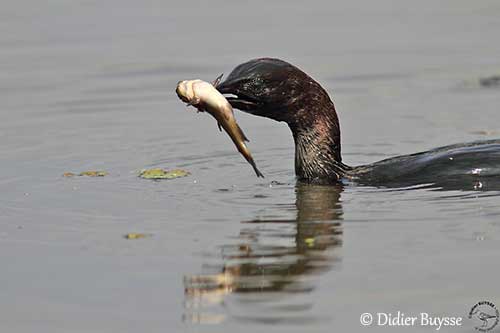
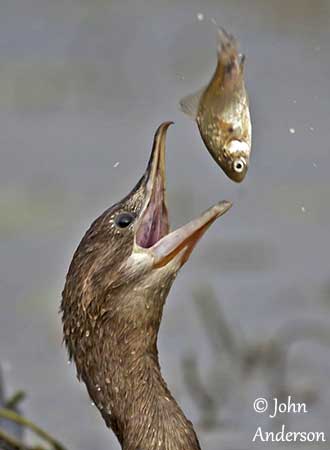
It usually forages alone or in small groups. After fishing expeditions, they often perch on rocks, stones, branches or reeds to let their wings dry.
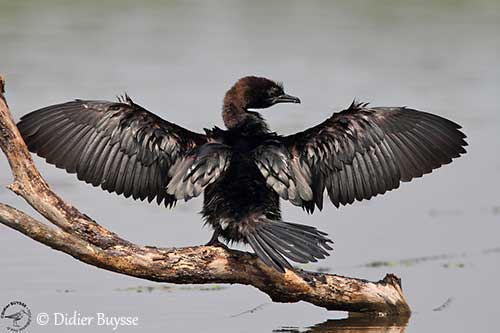
During the breeding season, they form large colonies with other species including Ardeidae (herons and egrets) but it often breeds near the Great Cormorant too.
The courtship displays are not described, but they are accompanied by calls.
The Pygmy Cormorant usually performs short-distance movements, but the species is also sedentary over large areas.
Populations from Black Sea and mainly N Caspian Sea leave the breeding grounds in late August, and return in March/April.
The species is vagrant in C Europe, Switzerland, S Germany, SW France, Belgium, Spain, Tunisia and Pakistan.
Cormorants need to run over the water surface to take-off, while performing active, rapid wingbeats. They use the wind to manage both landing and take-off.
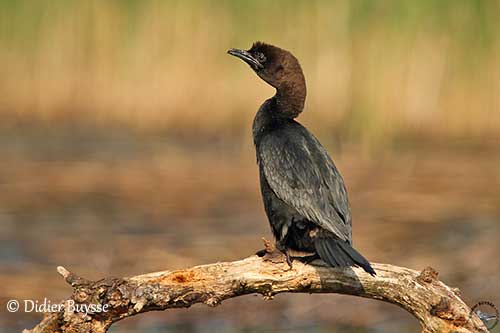
REPRODUCTION OF THIS SPECIES:
The laying occurs between April and July.
The Pygmy Cormorant breeds in colonies, often with other cormorants, herons and egrets.
It builds a nest with grass and twigs, lined with softer materials. It is placed in low tree or in reedbeds, near or over the water.
The female lays 3-6 eggs, and both adults incubate during 27-30 days. The young become independent 70 days after hatching.
PROTECTION / THREATS / STATUS:
The Pygmy Cormorant is affected by degradation of wetlands due to drainage for agriculture and changes in hydrological regimes. Persecution and hunting are also important problems, like fishing nets and marine pollution.
The population is placed in the band 45,000/139,999 individuals. The trend is increasing overall, with some stable populations.
The Pygmy Cormorant is not globally threatened, and currently evaluated as Least Concern.
